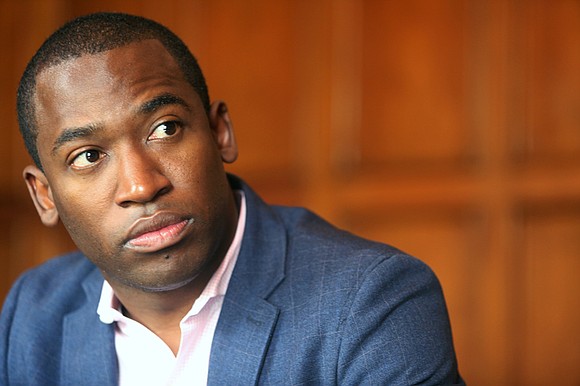Mayor on hook for school modernization plan with charter change signing
Jeremy M. Lazarus | 4/13/2018, 8:25 a.m.
Just a year ago, it was only an idea.
Now it’s the law.
Backed by a unanimous legislature, Gov. Ralph S. Northam has signed a new charter measure for Richmond that will require Mayor Levar M. Stoney to come up with a fully funded plan for modernizing every city school without a tax increase or explain why he cannot.
Paul Goldman, the political strategist who drafted the measure, led the campaign to get it on the ballot last fall when it won voter support and lobbied for its passage in the legislature. He said, “The mayor must at least try.”
Speaking at a press conference last Friday, Mr. Goldman said that the goal of the legislation is to get a plan in place.
“We have heard numerous estimates bandied about, that it would cost $500 million or $800 million or $600 million. But until there is a plan in place, there is no way to know. That’s all the voters asked for is that the mayor try to create a plan the city could move forward with. That’s not too much to ask.”
Mayor Stoney has not said how he will deal with the change to the City Charter that becomes effective July 1. It also requires him to deliver a plan by Feb. 1, 2019, if he can.
The mayor has said publicly that “he could wash his hands of it on July 1” if he chose to by simply saying it cannot not be done, but he has no plans to take the easy way out. He said he and his team would “explore everything. But if it can’t be done, I’m not going to blow smoke up the tails of city residents.”
He called it “easy to put a measure on the ballot that we’ll all have new schools. But someone has to find the dollars. That’s the hard part.”
Already, Mayor Stoney has indicated that he has done enough for the next few years. His proposed spending plan for the 2019 and 2020 fiscal years includes $150 million for new school construction, with an estimated $9 million a year to repay construction costs generated by a 1.5 percent increase in the city meals tax that he pushed through City Council earlier this year. The meals tax increase becomes effective July 1.
That money appears to be earmarked by the School Board to replace a middle school and high school in South Side and two elementary schools — one in South Side and one in Church Hill. But it would leave more than 30 buildings that the majority of students attend in increasingly poor shape — buildings the mayor has labeled “monuments to segregation” and that he promised to deal with in his 2016 election campaign.
The mayor did not propose any spending cuts in his spending plan to generate more funding for school construction. And so far, City Council, which is reviewing the plan and considering amendments, has not offered any reductions to add to the construction dollars.
According to the mayor, the city does not have much debt capacity available now, which is why he proposed the tax increase. But if the city’s debt capacity increases, as is expected in five years after current bonds are paid off, he does not believe the city will be able to replace dozens of schools, but would be limited to a few more buildings at best.
He also publicly has indicated that he sees no way to reduce spending to provide additional funds, despite assertions from Mr. Goldman that the budget has plenty of items that could be reduced, eliminated or reallocated to pay for a far larger school construction program.
The mayor insists that Mr. Goldman is wrong when he suggests a 3 percent reduction could generate $21 million a year additional for school construction or enough to provide at least $400 million in additional dollars to modernize schools.
“I’m not going to rob Peter to pay Paul,” Mayor Stoney said, adding he would not “gut” city agencies such as Public Works and Parks, Recreation and Community Facilities to find extra dollars, which he said would be necessary.
He indicated that in five years, after his first term ends in 2020 and the city would have more debt capacity, he does not expect the projected $300 million that might be available to go solely toward building new schools.
“We have to think about the communities the children are coming from. We can build a number of new schools over the next decade-plus. But if students are still coming from the same broken neighborhoods, what good is a new school building?” he asked.
Before building more schools beyond the emergency needs that the $150 million would address, such as replacing decrepit George Mason Elementary in Church Hill and relieving overcrowding at Elkhardt-Thompson Middle School, Mayor Stoney said the city would need to put in place a comprehensive plan that would also focus on “poverty mitigation, public safety and housing,” as well as new schools in order to improve overall conditions.
“I don’t have some magic money tree outside 900 E. Broad St. (City Hall). I have to work with banks and find real dollars,” he said.







